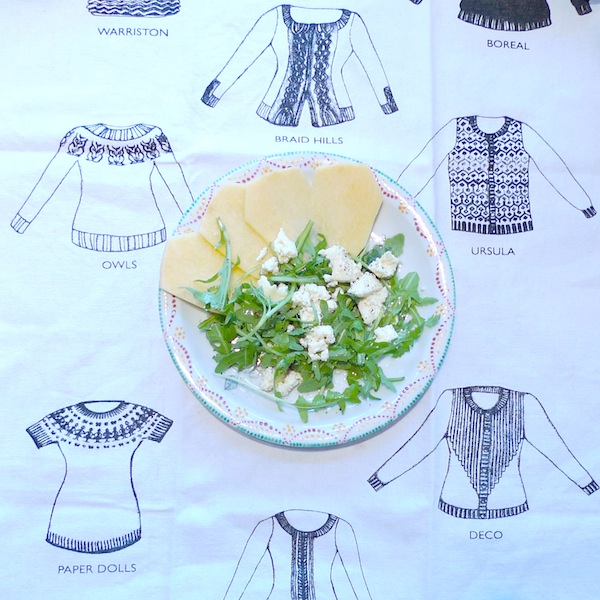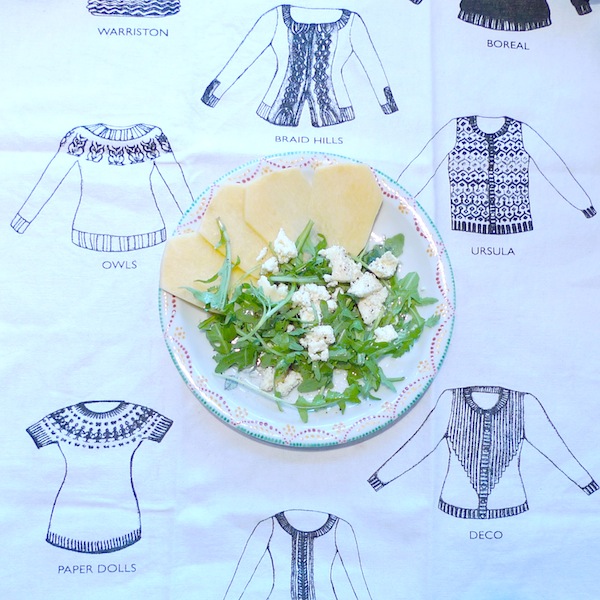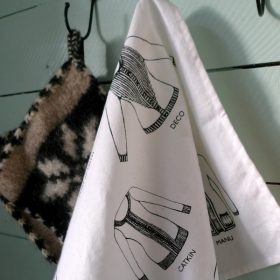Artists and designers
In the kitchen with Kate Davies
How did you get the idea of making a tea towel? I found it such a brilliant idea (thank you so much for the gift by the way, it is in good use too!)
Kate: This salt comes from Anglesey, a small island off the North coast of Wales, on which I used to spend my holidays as a child, and where sea salt has traditionally been produced for centuries. Its name is Halen Môn – which simply means “Anglesey salt” in Welsh. It is naturally produced and hand-harvested and I really think its the most delicious salt produced in the UK!
Me: Do you have any special recipe for this salt you would like to share?
Kate: Yes! I have a recipe for Crowdie — a simple-to-make Scottish curd cheese, which I imagine would also appeal to the Icelandic palate. The salt is added as the curds are draining, and it is essential for removing excess whey from the cheese. I think that a good quality sea salt, such as those produced in Iceland or Anglesey – makes all the difference to the final taste of the cheese. Anyone can make this cheese: the only special equipment* you’ll need is a square of butter muslin for draining, and you can buy citric acid for cheesemaking, and rennet in tablet form from many online retailers. Use your local milk, and experiment! Crowdie makes a superb accompaniment to roast vegetables such as beetroot, tastes wonderful in a Winter salad, or is delicious eaten simply on a Scottish oatcake.
* for my readers in Iceland, I found them at ostagerd.is
Me (later): Thank you so much for the recipe, I experimented using local milk and Icelandic geothermal salt. We had it with fresh rucola from my garden, fresh sliced rutabaga and olive oil. It was tremendously delicious! Also I read that Crowdie was introduced into Scotland by the Vikings in the eighth century! Back to the sources? We’ll be doing Crowdie often!
This recipe will make approximately 900g / 2lbs Crowdie
You will need:
8 pints / 4.5 litres good quality whole milk
1 tsp citric acid
1/4 tablet calf’s rennet or vegetarian rennet if preferred
1teaspoon sea salt
100ml water, boiled and left to cool
(optional) crushed black pepper or pinhead oatmeal for rolling
Butter muslin and colander for draining
thermometer
a large deep pan
slotted spoon
small plate
weights, or vase filled with water, for pressing.
Dish for storing
Instructions
1. Add the rennet to 50 ml cooled boiled water.
Stir, allowing the rennet to dissolve
Set aside.
2. Add the citric acid to 50ml cooled boiled water.
Stir, allowing the citric acid to dissolve.
Set aside.
3. Pour the milk into the pan and heat gently to 90F / 30C
4. Add the citric acid solution to the milk, gently combining it with the slotted spoon in an ‘up and down’ rather than circular motion to ensure an even distribution.
5. Remove the pan from the heat, put the lid on, and set aside for 30 minutes.
6. Add the rennet mixture to the pan, gently combining it with an up and down motion as before.
7. Heat the milk to 105F / 40.5C and maintain at this temperature for 3 minutes.
8. Line a colander with the butter muslin and place over a large bowl (if you wish to retain the whey) or the sink (if you do not). Carefully ladle the curds into the colander and allow them to drain for 15 minutes.
9. Add the salt to the curds, mixing it through carefully. Fold the corners of the muslin in over the salted curds and place a small plate and the weights (or water-filled vase) on top.
10. Allow the curds to drain under weight for an hour. Press the cheese into a dish, cover and refrigerate. Alternatively, roll the cheese in black pepper or pin head oatmeal, wrap and refrigerate.
11. Enjoy your Crowdie!




